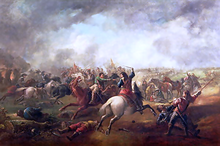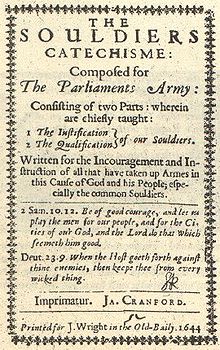New Model Army
|
|||

|
|||
| guide | |||
|---|---|---|---|
| Commander in Chief : |
Thomas Fairfax (1645–1650) Oliver Cromwell (1650–1658) |
||
| Headquarters: | London | ||
| Military strength | |||
| Active soldiers: | |||
| Conscription: | No | ||
| Eligibility for military service: | |||
| history | |||
| Founding: | January 6, 1645 | ||
| Resolution: | 1660 | ||

The New Model Army was the parliamentary army during the English Civil War , operational since early 1645. Commander-in-chief was initially Thomas Fairfax , while Oliver Cromwell commanded the cavalry , the " Ironsides ". The army was decisive for the victorious outcome of the civil war for Parliament and then enforced the execution of the king against the parliamentary majority. Cromwell came increasingly to the fore as a leading man. From 1650 he was commander in chief; supported by the army, he ruled England, Scotland and Ireland as lord protector from 1653 until his death . The army was disbanded after the restoration of the monarchy in 1660.
history
Formation of the army
After the course of the war had initially favored the troops fighting for King Charles I , Parliament decided, at Cromwell's instigation, to set up a newly organized army. In doing so, emphasis was placed not only on up-to-date equipment and tactics, but also on the fact that officer positions were not assigned according to social origin, but according to ability. That is why the new army was called the New Model Army . The installation began in the winter of 1644 and was largely completed in February 1645.
Civil war
→ see main article English Civil War
Recapturing Ireland
→ see main article Recapturing Ireland
Anglo-Dutch War
→ see main article Anglo-Dutch War (1652–1654)
Major battles
The New Model Army won its first important victory on June 14, 1645 in the battle of Naseby . The Battle of Preston (1648) was also won by the New Model Army. The New Model Army was also involved in Cromwell's campaign against Ireland , which began in 1649. Many of their soldiers settled there after the fighting ended, mainly in Ulster . Since there were major problems with the payment of wages, many soldiers were given a piece of land on Irish soil as compensation.
structure
The infantry of the New Model Army consisted of about two-thirds of Thunderers , while with the remaining infantry to pikemen acted. The cavalry consisted of cuirassiers and arquebus riders . There was also a regiment of foot soldiers on horseback, the so-called dragoons . In addition, the New Model Army included a volunteer unit, the " Forlorn Hope " company , which took on particularly dangerous tasks in battle.
equipment
Few soldiers in the New Model Army were armed with armor . In heavy riding and with some pikemen, a combination of a visorless helmet and breastplate was common, but a long robe made of reinforced leather ("buff coat") was preferred.
Religious attitude
In the New Model Army, power of command was assigned regardless of social ranking. In doing so, she broke the tradition of other contemporary armies, in which only nobles could hold high offices in the army. Since Puritans were considered particularly capable because of their beliefs, a particularly large number of commanders of the Puritan faith were hired. These promoted the spread of their faith in the troops. The army chaplains encouraged the soldiers to study the Bible and discuss religious issues. The soldiers were also led into battle singing psalm.
The result was a religiously understood alliance between men and officers, which led to a higher morale. In addition, the religious discussions in the troops promoted communication skills. This was of crucial importance for the crew's later interference in the social affairs of the kingdom.
literature
- Ian Gentles: The New Model Army. The New Model Army in England, Ireland and Scotland, 1645–1653. Blackwell, Oxford et al. 1992, ISBN 0-631-15869-3 .
- Keith Roberts: Cromwell's war machine. The New Model Army 1645-1660. Pen & Sword Military, Barnsley 2005, ISBN 1-84415-094-1